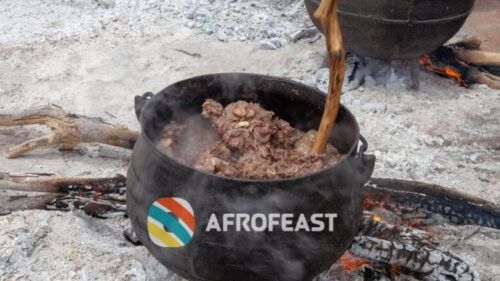Kikalayi Pork The Ugandan Way
Guys, Kikalayi is the real deal in Uganda right now, besides the various medals the country has to its name. Small and landlocked with a troubled past, dont underestimate this country.
Let’s see how it scores on the global scale: it was once ranked the most friendliest country in the world (2017), it was the most entrepreneurial country in the world in 2014, it is the source of the mighty River Nile, it is one of only 3 countries in the world with Mountain Gorillas, it conquered the British empire (LOL), and that’s not all: it is the second biggest pork eater in the world (after China of course)! You want proof? Wait a minute, that will come 🙂
Now, let’s delve into this interesting topic.
1. Entrepreneurship is the backbone
As you traverse the country you’ll meet men, women, and children engaged in some form of economic activity. From farming to vending, hawking, boda boda riding, hair saloons, taxis and bus services, retail and wholesale businesses, the streets of Uganda and rural trading centres teem with people trying to eke a living. Don’t buy that bs that Africans are lazy, come see for yourself…!

According to the Global Entrepreneurship Monitor, Uganda was the most entrepreneurial country in the world in 2014. Among the millions of informal and formal businesses are what we locally call “Pork Joints”, dedicated makeshift shelters serving this beloved dish. Just like Kenyans enjoy “Nyama choma” , a generic term that refers to roasted goat, chicken and beef meat, Ugandans relish pork.
According to recent statistics, the average consumption of pork per person per year in the country is 3.5 kg. While this pales in comparison to China, it positions Uganda as the top consumer in Africa and second globally.
Fun fact: Pork consumption is not only concentrated in Uganda’s urban areas, it can be found almost anywhere in the country. In Kampala, notorious suburbs known for pork eating include Wandegeya, Nankulabye, Kikoni, Katanga (all near Makerere University), Luzira, Komambogo, Namugongo and ofcourse the infamous Kabalagala-Kansanga-Muyenga corridor (loads of expats love this middle class area).
Upcountry, you can find pork in almost every trading centre. In Tororo town, pork is sold in temporary makeshift structures in Water Village, Haji Koire, Kisangani, Mailo 2, 3, 5 and many other pork joints.
2. “Ogwang” and Changing Traditions
In my native Dhopadhola language, pork is called “Ogwang,” literally meaning “animal. Pig ears are considered a delicacy, and I must admit, they truly are!
Surprisingly, there was once a taboo against women eating pork. Thankfully, times have changed, and both men and women can now enjoy “Ogwang” side-by-side at Pork Joints.
3. How to Prep Ugandan Pork
Ugandan pork is typically prepped in two ways: roasted and “Kikalayi.” Kikalayi comes from the Swahili word “Kalai“, meaning “tin” or wok.
Traditionally, Ugandans used two types of cooking pots: clay pots and Kalais or woks.
For traditional, slow cooked meals such as blackpeas, chicken or beef, our ancestors mainly used clay pot (ayiga in Dhopadhola).

However to fry things in bulk, especially in commercial settings they used kalayis. The Baganda, a dominant tribal group in Uganda, call pork fried in Kalayi “Kikalayi”, or “of the Kalayi” or cooked in the Kalayi. The name, a recent phenomenon, is now used widely in the country.

Other families boil pork, however that cooking method is unpopular and probably unsafe. Ugandans love pork with its fat drained out.
Kikalayi is a flavour explosion. Tender pork is marinated in a delicious blend of curry, tomatoes, onions, and sometimes cabbage, then deep-fried to perfection. It’s traditionally served with boiled cassava, bananas (matooke), posho (maize meal), kwon / kalo (millet bread), and kachumbari (a refreshing tomato and onion salsa). Depending on the region, you might find variations with oil-boiled Irish potatoes or additional vegetables.
I love it with kwon or posho.

4. How much does Kikalayi cost
Prices for Kikalayi range from Ugx 20,000 to 30,000 per serving, while roasted pork goes for Ugx 5,000 to 10,000 per skewer, depending on the size and location. I personally prefer ordering per kilo so you know what to expect.
It’s important to note that Ugandan cuisine is generally mild, so if you crave a spicy kick, you might need to add some extra hot sauce.
5. Kikalayi is a group activity
Rememeber, pork eating is a social activity in Uganda. Before you plan a pork joint raid, ask friends if they would like to come along. Ofcourse they will say “yes” – who wouldn’t? See, pork is best eaten in groups especially during the weekend. But you can also order Kikalayi online, including from local restaurants via facebook and whatsapp although you will not enjoy the experience.
Three to five persons is perfect. If you can afford hosting a bigger group why not? And don’t just go out, eat and return to your hotel room – order some drinks as well – Bell Larger, Nile Special Larger, Uganda Waragi (Muzinga) – this one is not for the faint-hearted and inexperienced – drink at your own risk; Tusker Malt etc and storm the night clubs after.
Unlike foreign countries where drinking is highly regulated, in Uganda you can start partying at 6am in the morning and finish three days later and no one will harass you, aint that beautiful?
Just a gentle reminder – if you ask people out in Uganda you foot the bills – yes. Don’t be selfish lol.
6. Pork Tourism: A Unique Ugandan Experience
The love for pork has led to the rise of “pork tourism.“For instance, there is a weekly pork festival that takes place in Kabagarame, the outskirts of Bushenyi and Ishaka towns (western Uganda) about 350km from the capital Kampala.
This lively market attracts over 2,000 people every Saturday, with vendors offering a variety of pork dishes. Friends and families gather from all corners of the country to indulge in this culinary celebration, often accompanied by music and drinks. Here, pork is typically served with kalo, matooke, and even “Katunkuma,” small boiled/steamed bitter berries or African eggplants. If you’re a pork enthusiast visiting Uganda, this is a must-do experience.
7. Beyond the Weekly Feast: The Annual Pork Festival
If you are a pork fan visiting Uganda you shouldn’t miss the fan at Komambago every Saturday. You can’t talk about pork and leave out the pork festival which by the way, is an annual event with no fixed date that attracts thousands of revellers.
This year’s edition already took place on 1st April. This massive event draws thousands of revellers eager to savour Ugandan pork in all its glory.
Conclusion
On your next visit to Uganda, don’t miss the opportunity to experience pork the Ugandan way. From the succulent “Kikalayi” to the perfectly roasted skewers, Ugandan pork offers a delicious and unforgettable adventure. So, come hungry, embrace the vibrant atmosphere of a Pork Joint, and create lasting memories that will have you yearning for more.
12 Unforgettable Ugandan Street Food Delights (2024)
